|
|
JEFFERSON JR. HIGH
SCHOOL AND HIGH SCHOOL
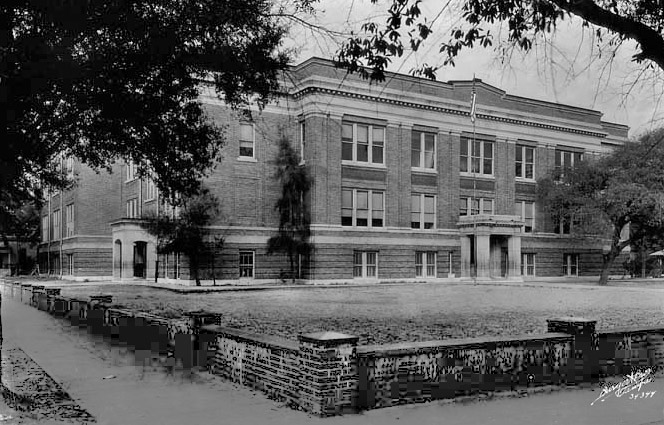
Thomas Jefferson
Junior High School, Jan. 1932
Burgert Brothers photo from the Tampa-Hillsborough County Public
Library
After Hillsborough County High School moved out of this building on
Highland Ave.,
Thomas Jefferson Junior High School was founded here in 1928.
Under the guidance of principal D. W. Waters, it transitioned
into a high school in 1939 and its first class graduated in 1942. |
|
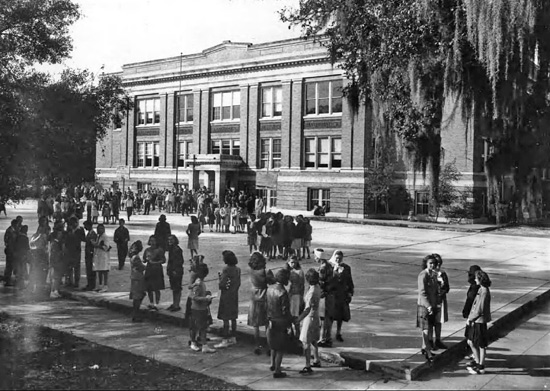 |
Jefferson
High occupied this old building until 1966-67, when the school board
decided that its location no longer met modern educational
requirements. The school was closed and Jefferson ceased to
exist.
Students outside Jefferson High School,
from the 1947 Monticello. The school yard was paved over in
concrete in the mid-1940s during the WWII years.
Robertson & Fresh photo from USF Digital Archives
|
|
In 1967, this building became the
2nd home of George Washington Jr. High. Jefferson High School
was reborn in 1971 with no building of its own, so it shared the A.
P. Leto High School
facility through June, 1973. In the fall of 1973, the
Jefferson Dragons moved into their new and current facility at 4401
W. Cypress St.
 The
paths of Jefferson High, Hillsborough High and George Washington Jr.
High would ironically converge during the 1975-76 school year, while
Hillsborough High School on Central Avenue was being renovated.
HHS 10th grade students attended George Washington Junior High for
the afternoon session at the 2704 N. Highland Avenue location--the
same facility built for them in 1911. Eleventh and twelfth
grade HHS students attended the new Jefferson High School building
at 4401 W. Cypress St. Jefferson students attended classes
from 7am to noon, with an overlap period for some students needing
extra credit from noon to 1pm. Hillsborough students attended the
afternoon session from noon until 5pm. The
paths of Jefferson High, Hillsborough High and George Washington Jr.
High would ironically converge during the 1975-76 school year, while
Hillsborough High School on Central Avenue was being renovated.
HHS 10th grade students attended George Washington Junior High for
the afternoon session at the 2704 N. Highland Avenue location--the
same facility built for them in 1911. Eleventh and twelfth
grade HHS students attended the new Jefferson High School building
at 4401 W. Cypress St. Jefferson students attended classes
from 7am to noon, with an overlap period for some students needing
extra credit from noon to 1pm. Hillsborough students attended the
afternoon session from noon until 5pm.
|
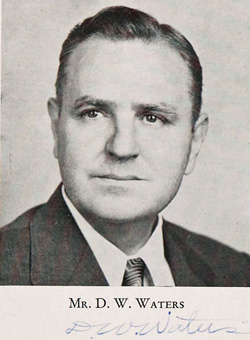 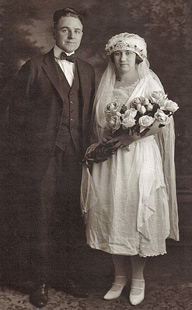 D.W. Waters was born around 1899 - 1900 in
Mississippi. He came to Tampa for a teaching job and soon married
Leannah Susan Parker around 1921. They had a daughter named Wanda
around 1923 and a son D.W. Jr. around 1931. In 1930 he was a public
school teacher and by 1938, he had become Jefferson Junior High
School principal when it transitioned into a high school in 1939.
His son, D.W. Waters, Jr. became the principal of Miles Elementary.
Both DWs were on the the board of the Suncoast Schools Federal
Credit Union. D.W. Sr. owned the property at the corner of
N.Dale Mabry and Fletcher where the Publix is and across the street
at Moran Rd. all the way down to where the lake is behind where the
Japanese steak house was. (Info and wedding photo courtesy of Donna Waters.) D.W. Waters was born around 1899 - 1900 in
Mississippi. He came to Tampa for a teaching job and soon married
Leannah Susan Parker around 1921. They had a daughter named Wanda
around 1923 and a son D.W. Jr. around 1931. In 1930 he was a public
school teacher and by 1938, he had become Jefferson Junior High
School principal when it transitioned into a high school in 1939.
His son, D.W. Waters, Jr. became the principal of Miles Elementary.
Both DWs were on the the board of the Suncoast Schools Federal
Credit Union. D.W. Sr. owned the property at the corner of
N.Dale Mabry and Fletcher where the Publix is and across the street
at Moran Rd. all the way down to where the lake is behind where the
Japanese steak house was. (Info and wedding photo courtesy of Donna Waters.)
D.W Waters, 1944 Monticello
|
Photos
from the 1944 Monticello
|
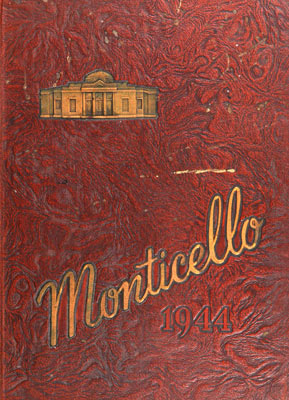
|
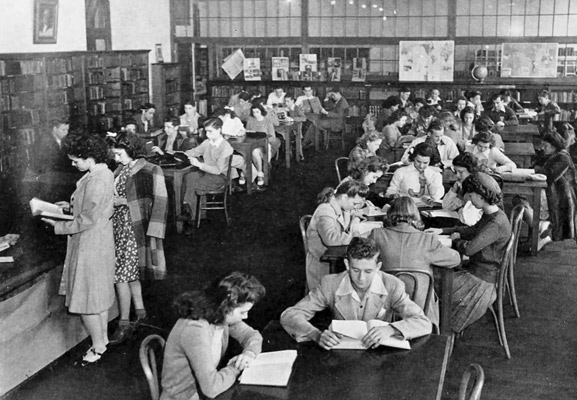 |
| |
Students in the library, 1943-44
|
|
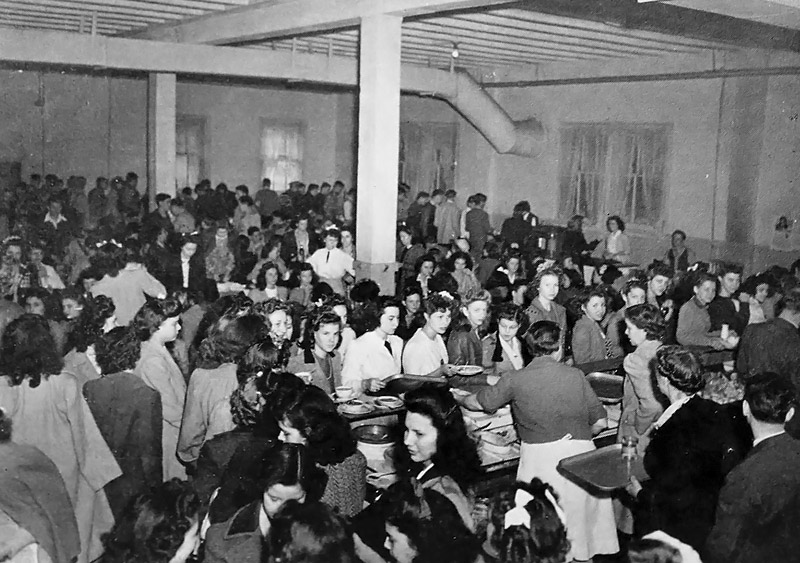 |
|
Students in the cafeteria, 1943-44 |
|
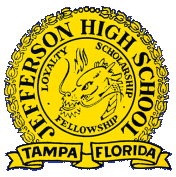 |
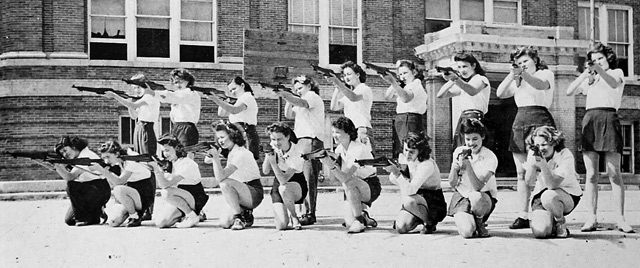 |
| |
The girls rifle team, 1943-44 |
|
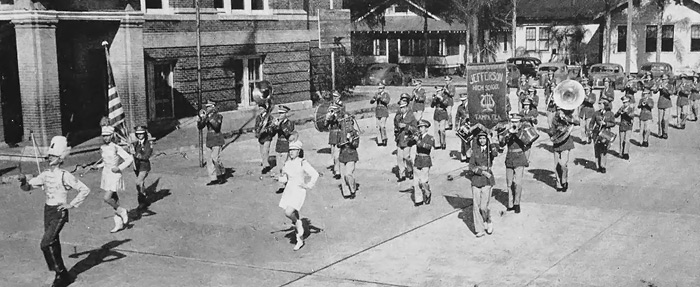 |
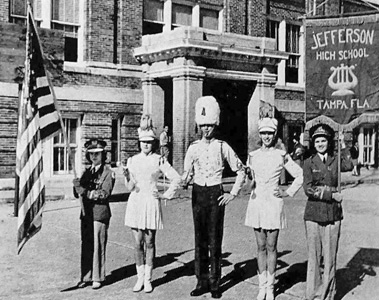 |
|
The JHS marching band practicing on the patio, 1943-44 |
|
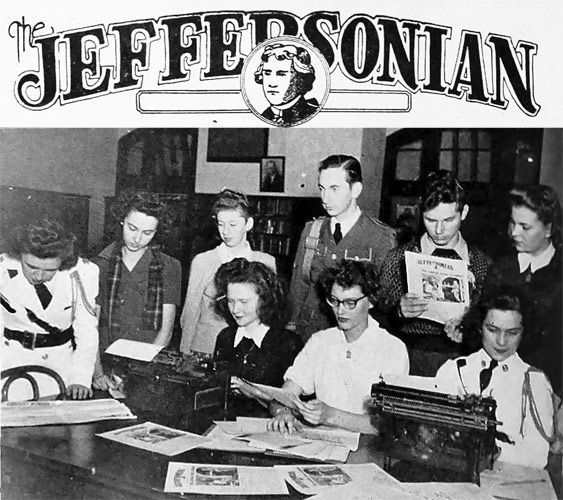 |
The Jeffersonian was the school's bi-weekly newspaper, published
by the journalism class. |
| |
|
Photos from the 1946
Monticello
|
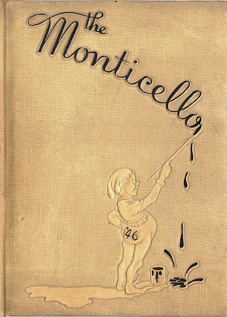 |
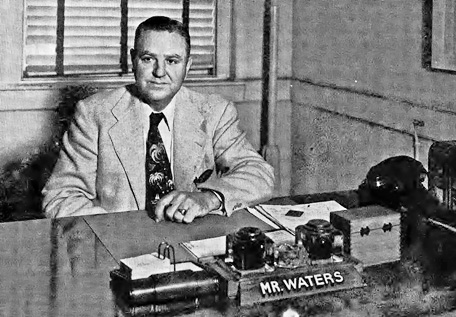 |
|
The
elf-like character was named "Tommy" and was used as a mascot
for the yearbook. He appears in many of the book's photos. |
Credit is
given to Mr. D. W. Waters for the vast accomplishments achieved
by the school in the past five years, since becoming a high
school:
"No one
knows better than Tommy how much of the credit for this
achievement belongs to the skipper--our principal , Mr. D. W.
Waters--for his willingness to lend a hand whenever needed; for
his guidance and understanding; and for his love of Jefferson
and each of its students.
Not a
football, basketball, baseball game or track meet goes by but he
is there, for, having played baseball for several years himself,
he is a natural for all sports contests. And usually with
him are the members of Jefferson's first family--his wife,
daughter and her husband and child, and his son--all are staunch
Dragon rooters even down to one year old Sharon.
He also
likes to visit classes and when a substitute is not available,
"pop" takes over, both to his and the student's delight.
He likes even more to play checkers and chess, and spends spare
moments playing in a never ending tournament with the men
teachers. The "spares" are usually few and far between, for
there's always something or somebody ready to claim the time and
attention of Jefferson's top man--Mr. D. W. Waters. |
|
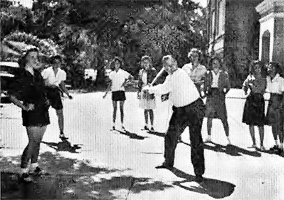
Three and
two on the boss
|
|
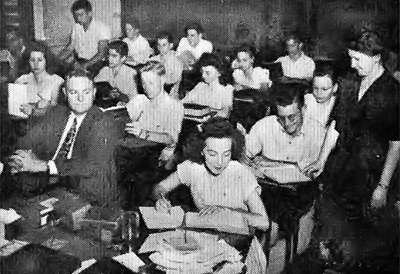 |
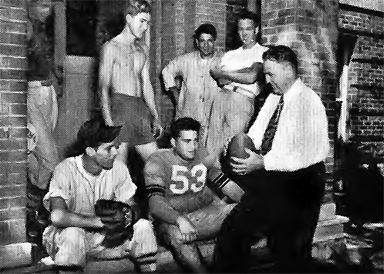 |
|
Principal
caught peeking |
Some
championship advice |
|
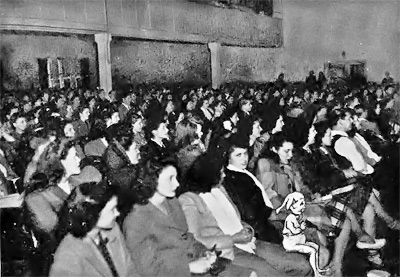 |
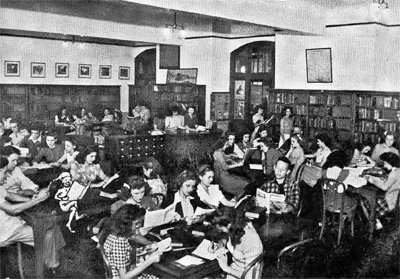 |
|
Tommy takes
in a Jefferson show at assembly.
Notice the balcony at top left. |
Tommy spends
a quiet hour in the library. |
|
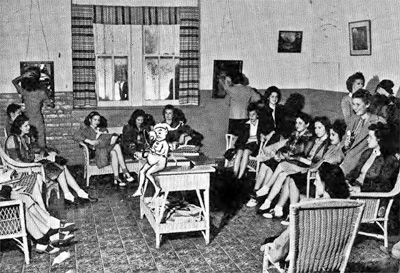 |
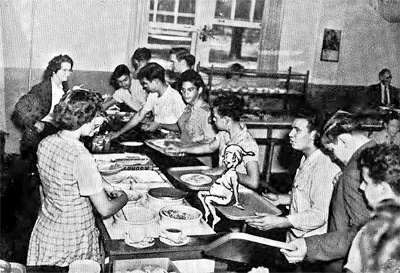 |
|
Tommy shows
the girls the proper way to primp. |
Tommy gets
taken for a try ride in the lunch room. |
Photos from the 1947
Monticello
|
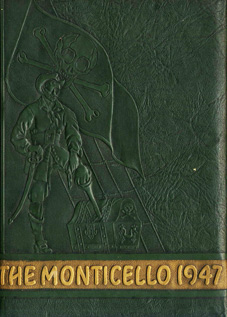 |
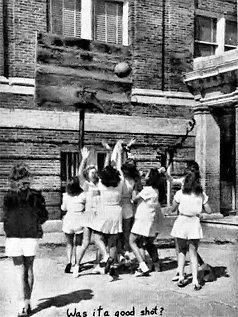 |
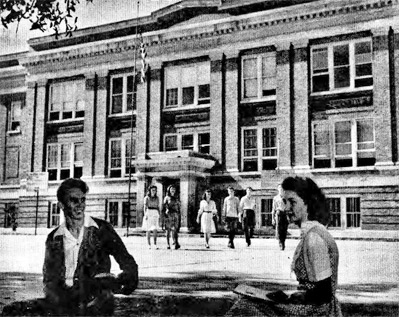 |
|
The 1947
Monticello had a Gasparilla pirate theme. |
Girls
basketball on the front patio |
School's out
for the day |

|
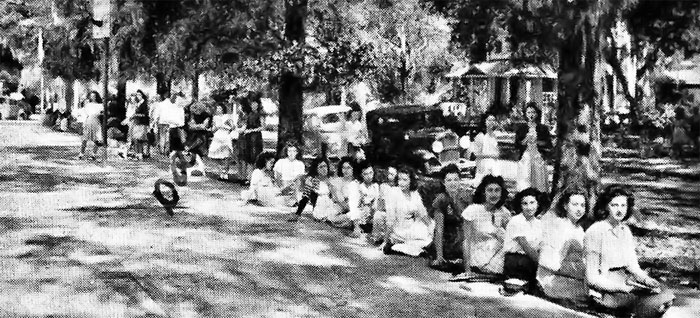 |
|
Girls sitting
in the shade |
| |
|
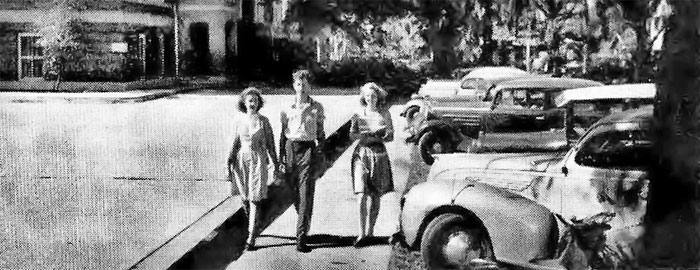 |
|
A stroll down
the parking lane |
| |
|
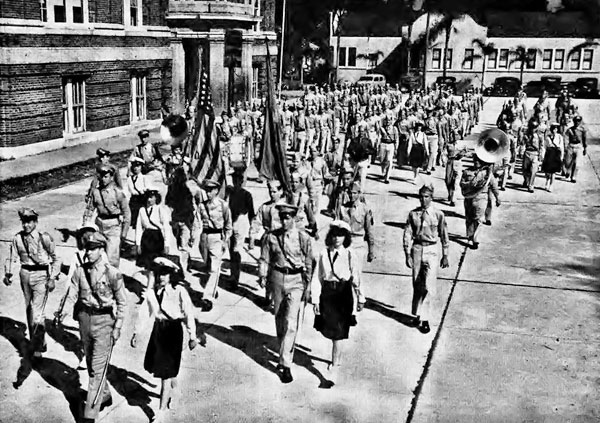 |
|
ROTC marching
on the front patio |
| |
Photos
from the 1949 Monticello
|
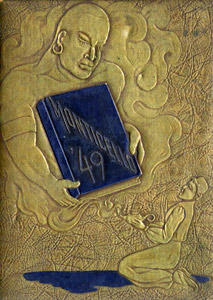
The 1949 Monticello had a Middle Eastern literary theme. |
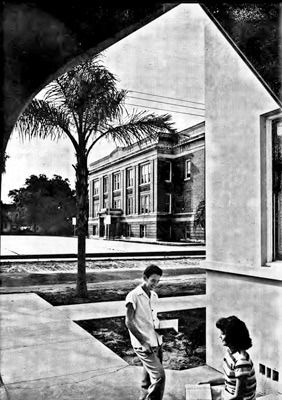 |
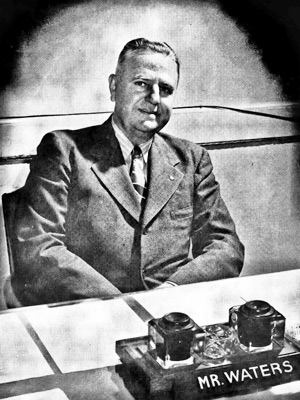 |
| |
|
|
|
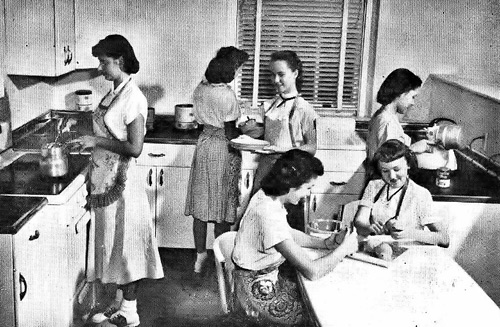 |
On the list of every high school girl as a preparation for her
future in the home is home economics.
The Home Economics department of Jefferson has the newest and
most efficient equipment of any high school in Hillsborough
County. There are eight completely equipped modern
kitchens including electric dishwashers and frozen food units. |
|
|
|
|
The shop department with its new machinery is an efficient
workshop for all types of manual training.
|
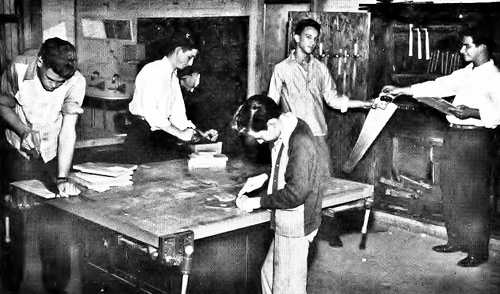 |
|
|
|
|
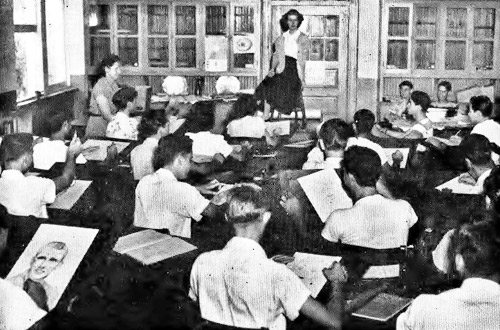
|
Among the new clubs that have been received with enthusiasm is
the Art Club and the Camera Club sponsored by Mrs. Evelyn Dale.
Each of these clubs has a waiting list and an interesting
program for next year. |
|
|
|
|
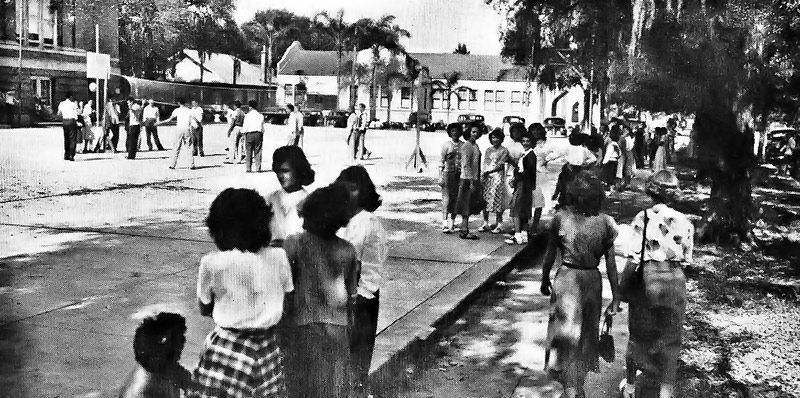 |
|
Lunchtime on campus
|
|
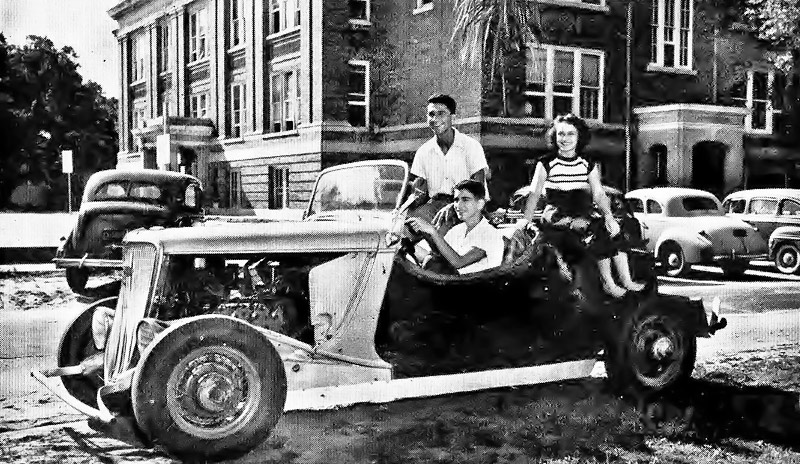 |
|
Sophomore class
President Victor Spoto, VP Louis Monteleone and Secretary
Rosalie Durand |
| |
|
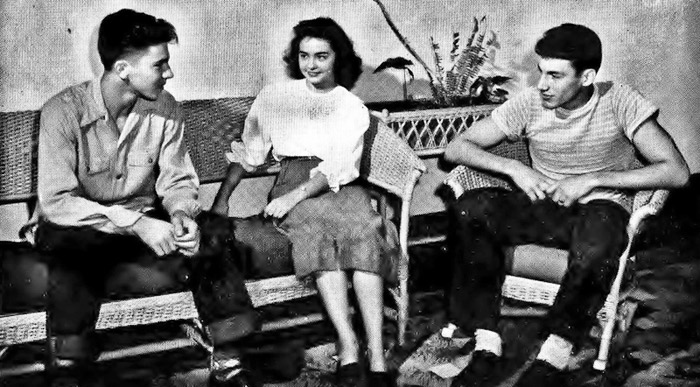 |
|
Left to Right:
Junior class VP Andrew Puleo, Secretary Gloria Gonzalez, and
President
Richard "Rick" Casares
Read about Rick Casares and his multi-talented athletic
accomplishments, along with photos, including the javelin he
used to win the event in numerous track meets.
Here at the
Jefferson High School Alumni Museum at TampaPix.
|
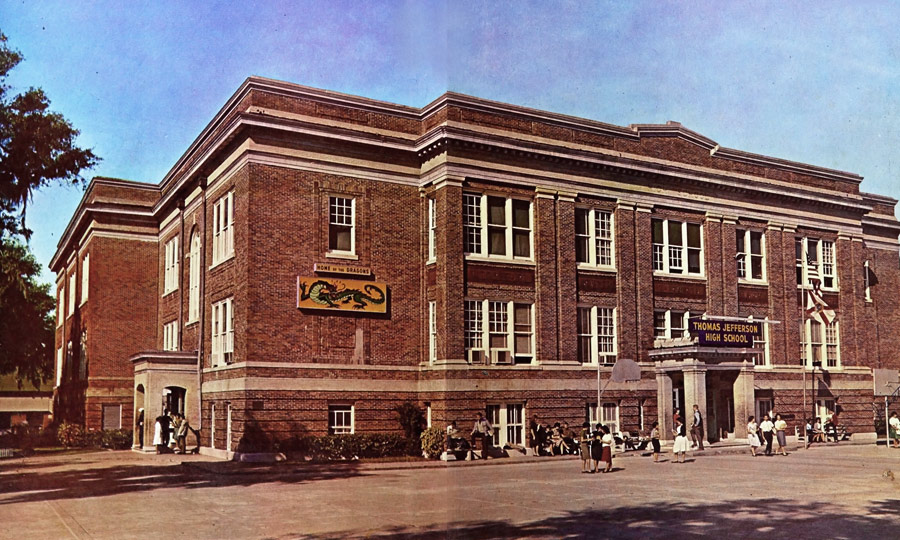
Jefferson High School, 1961-62
|
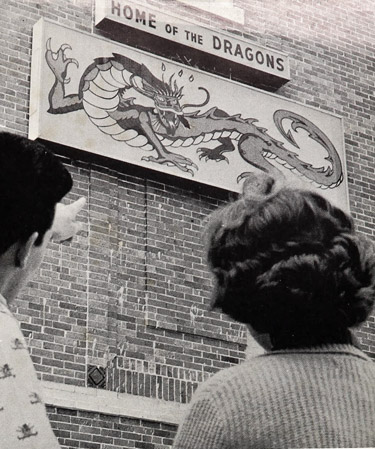 |
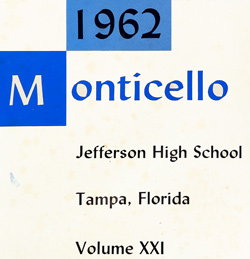
Photos from the 1962 Jefferson yearbook "Monticello" |
|
This sign is now displayed at the school's current location on
Cypress Ave. in Tampa
|
|
|
Jefferson hasn't always had a gymnasium.
In fact, up to 1953 we had none of about which to talk.
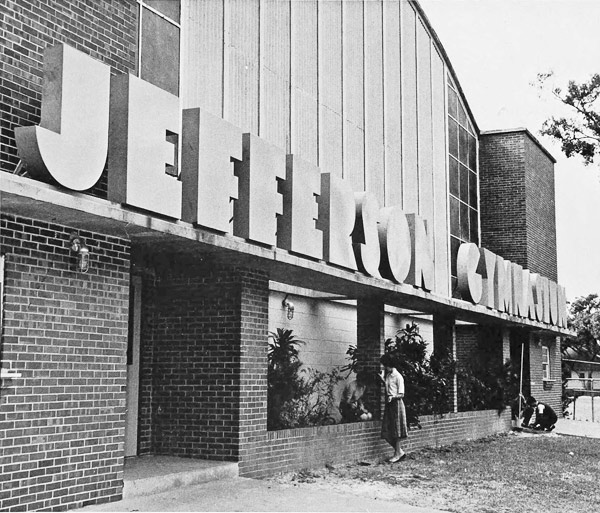
|
In that year under the
administration of Mr. Ateo P. Leto, the principal of Jefferson at
that time, the Jefferson gymnasium of today was built. It was an
exciting year for all concerned for this was a big addition to our
school. Everyone at Jefferson is proud of their gymnasium and they
should be for it is one of the newest and best maintained in the
city. In the gymnasium are also housed the band room, the locker
room used by the athletes, and also both the boys and girls
physical education locker rooms.
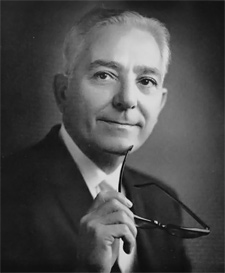
A. P. Leto as
Principal of Chamberlain
High School, 1960. |
|
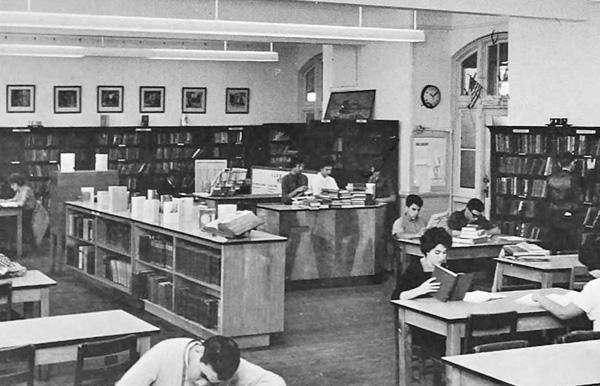 |
Students in the Library. This is now the location of the D.
W. Waters media center and the Jefferson High School Alumni
Museum. |
|
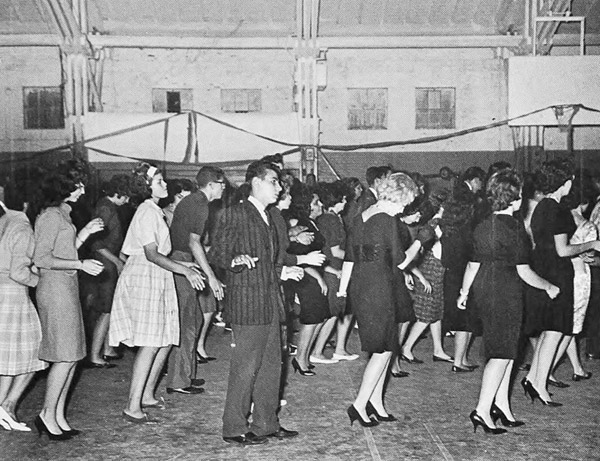
|
Dancing the hully-gully, a new dance craze that is danced without
a partner, students at homecoming dance get ready to kick to the
left.
From the 1962 Monticello.
|
|
Student office assistants help Mr. Garcia keep his office
running smoothly. Working hard are Roy Carrasco, Dolores
Garcia,
Tony La Russa,
and Lorraine Bascilio.
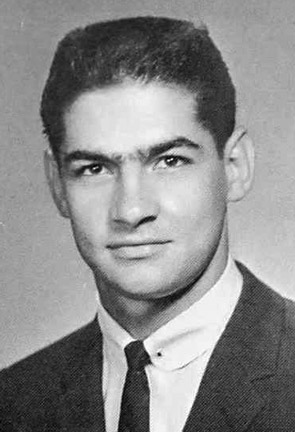
Tony La Russa
Class of 1962 |
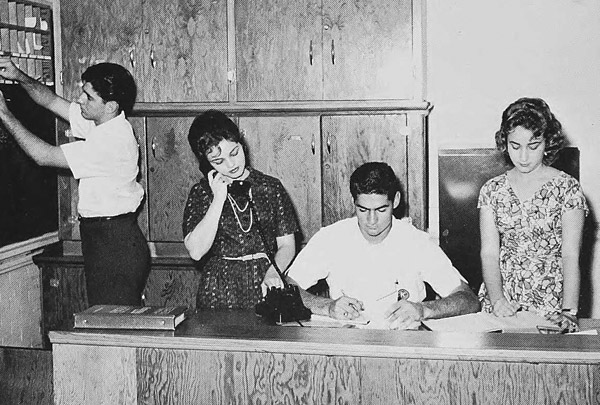 |
| |
|
|
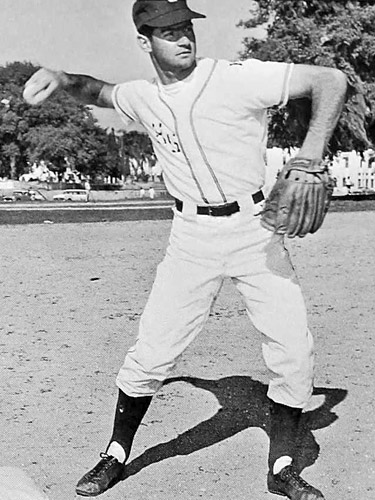 |
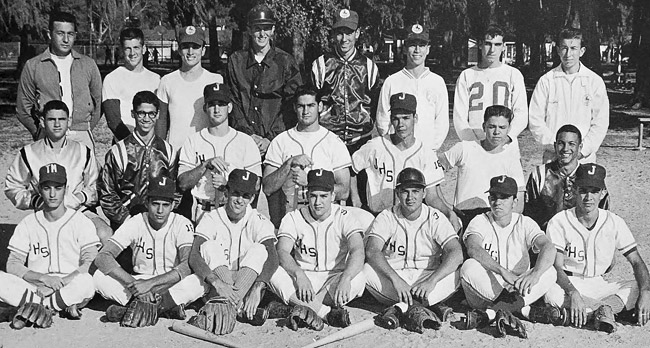 |
|
Tony La Russa, Shortstop
City-Conference-District
Champions |

1962 Jefferson Dragons Baseball, Tony La Russa, 2nd Row, 4th
from left |
|
Anthony
"Tony" La Russa, Jr. (born October 4, 1944) is a former Major
League Baseball manager and infielder, best known for his
tenures as manager of the Chicago White Sox, Oakland Athletics,
and St. Louis Cardinals. La Russa managed teams to six league
championships and three World Series titles, and ranks third in
all-time major league wins by a manager, behind Connie Mack and
John McGraw.
As a
player, La Russa made his major league debut with the Kansas
City Athletics in 1963. After a shoulder injury the following
off-season, he spent most of his career in the minor leagues. He
spent parts of five other seasons in the major leagues, playing
for the Kansas City/Oakland Athletics, Atlanta Braves, and
Chicago Cubs. His final big-league appearance came in 1973 with
the Cubs, but he continued to play in the minor leagues until
1977. Following the end of his playing career, he earned a Juris
Doctor degree from Florida State University College of Law.
Tony was
inducted into Major League Baseball's Hall of Fame on July 26,
2014. Read more about it and Tony at this Tampa Bay Times
article by Marc Topkin:
Tampa upbringing crucial to La Russa's
Hall of Fame career
Click plaque to see larger |
BRAULIO ALONSO
Braulio Alonso (December 16, 1916 – June 5, 2010) was a high
school and junior high school teacher and principal of Jefferson
High School from 1958 to 1962. He served as the first
Hispanic president of the National Education Association.
|
|
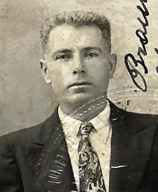
Braulio's father, Braulio Alonso-Gonzalez, was from
Oviedo, Spain and immigrated to Tampa in 1911, at age 22,
from Havana, Cuba on the S.S. Olivette.
At
right: Braulio Alonso (Jr.) senior picture in the
1935 Hilsborean |
Alonso,
whose first language was Spanish, was born in Ybor City to
Oviedo, Asturias, Spain native Braulio Alonso-Gonzalez and Luisa
Corces, a Florida native whose parents immigrated here
from Spain. Both Braulio Sr. and Luisa were cigar makers
in Ybor City and members of the Centro Asturiano social club.
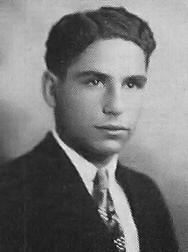 |
Braulio (Jr.) went to work at the age of 10 in order to
help support his family and graduated from Hillsborough
High School as valedictorian in 1935. In 1939,
Alonso graduated from the University of Tampa, also as
valedictorian. Braulio married Adelfa "Bebe" Diaz,
an elementary school educator, in August 1941. They had
two children. |
 |
|
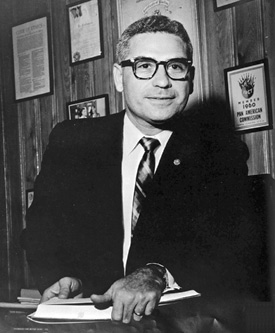
JHS Principal Braulio Alonso, 1962 |
|

Alonso
began his teaching career as an English teacher, then teaching
chemistry and physics at Plant High School before WW2.
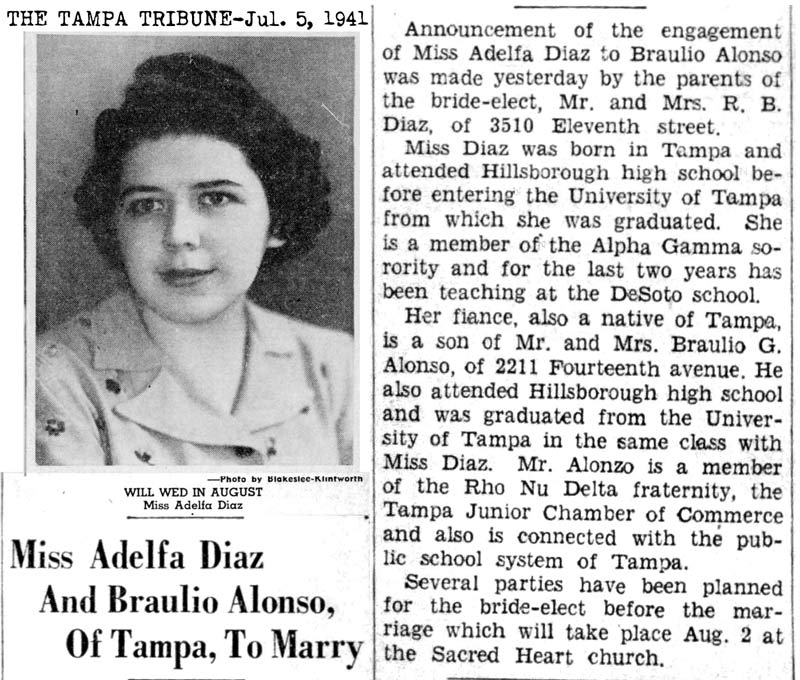
On Aug.
2, 1941, Braulio married Adelfa Diaz, a daughter of Ramon
Benito Diaz and Adelfa Yanez Diaz of 3510 11th St.
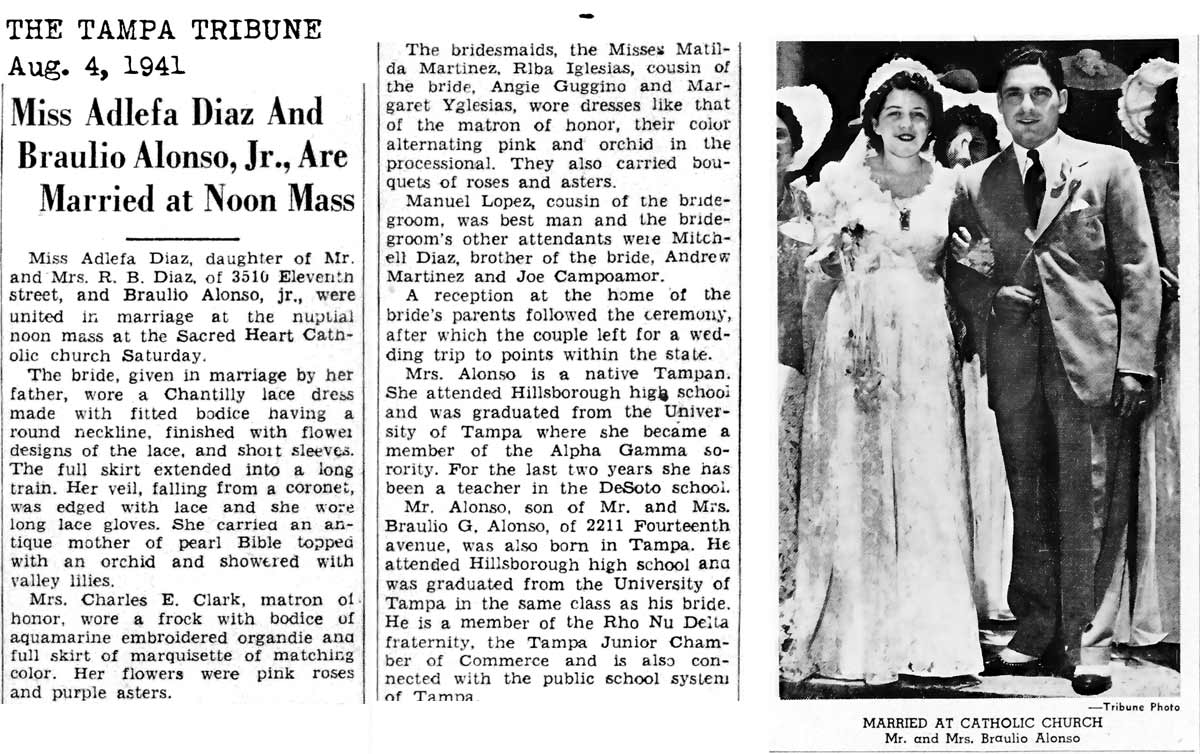
Braulio entered the US Army in October 1941 as a private and
was immediately sent to Officer Candidate School. He
served with the 85th infantry Division in North Africa and the
Italian Campaign as Battery Commander in the 328th Artillery
Battalion and was in the first group of allied officers to enter
Rome. Major Alonso was discharged in November 1945. He received
the Bronze Star and Purple Heart with Cluster.
After the war, he
returned to public education as director of Adult Education and
On-the-Job Training for Veterans from 1946 to 1953. Alonso
pioneered the present-day Adult High School. During the
summers he attended the University of Florida where he earned a
Master's and Ph. D. At the time, he was providing also for the
college education of his two younger sisters, Teresa and Zoraida,
as well as supporting his family. |
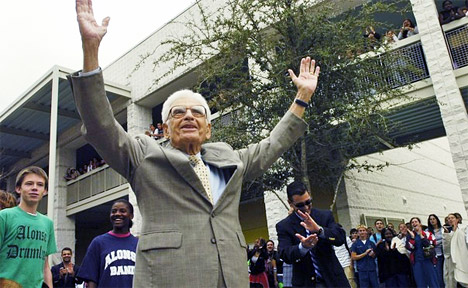 One
of Alonso's lifelong passions had been to improve the schools
and champion the teachers. In pursuit of that mission, he served
as president of the Hillsborough Education Association
(1951–1956) and then as President of the Florida Education
Association in 1957. He was especially proud of his role
as one of the educators who contributed toward desegregating the FEA. Braulio was elected president of the National
Education Association and took office in July, 1967. In 1968
masses of Florida teachers resigned in protest over budget cuts.
Braulio ended his teaching career by resigning as principal of
King High School in solidarity with the teachers. The county
refused to rehire him after the protest. Braulio later
became the NEA's director of international relations and
traveled the world representing the NEA. He retired his
post at the NEA in 1983. In 2001, Braulio Alonso High School was
opened in honor of Dr. Alonso. One
of Alonso's lifelong passions had been to improve the schools
and champion the teachers. In pursuit of that mission, he served
as president of the Hillsborough Education Association
(1951–1956) and then as President of the Florida Education
Association in 1957. He was especially proud of his role
as one of the educators who contributed toward desegregating the FEA. Braulio was elected president of the National
Education Association and took office in July, 1967. In 1968
masses of Florida teachers resigned in protest over budget cuts.
Braulio ended his teaching career by resigning as principal of
King High School in solidarity with the teachers. The county
refused to rehire him after the protest. Braulio later
became the NEA's director of international relations and
traveled the world representing the NEA. He retired his
post at the NEA in 1983. In 2001, Braulio Alonso High School was
opened in honor of Dr. Alonso.
Alonso being
honored at the school named after him, 2001
Braulio Alonso's Obituary
Photo from
Alonso High School Website
Portrait and Memorial
|
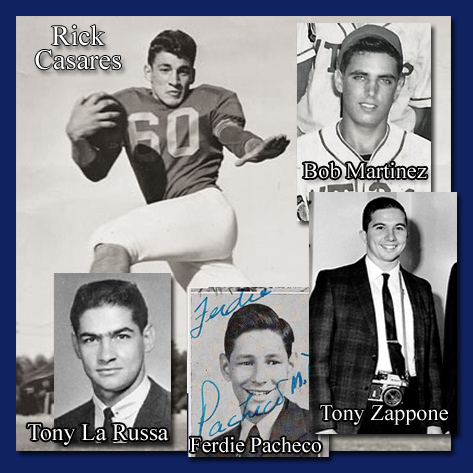 Notable
alumni Notable
alumni
-
Ferdie Pacheco (1944) Personal physician for Muhammad Ali
-
Rick
Casares (1950) AFL/NFL football player
-
Bob
Martinez (1950) Former Tampa mayor Florida governor
-
Tony
La Russa (1962) Major league baseball player/manager
-
Joe
Lala (1965) Musician & Actor
-
Tony
Zappone (1965) Author, photojournalist, broadcaster
-
Fred
McGriff (1981) Major league baseball player
-
Oscar
Smith (1981) NFL football player
-
Luis
Gonzalez (1985) Major league baseball player
-
Tino
Martinez (1985) Major league baseball player
-
Coleman Bell (1988) NFL football player
-
Torrance Small (1988) NFL football player
-
Kirby
Dar Dar (1989) NFL football player
-
K. D.
Williams (1990-91?) NFL football player
-
Keith
Newman (1995) NFL football player
-
Reche
Caldwell (1997) NFL football player
-
Tarence Kinsey (2002) NBA Basketball player
-
Andre
Caldwell (2003) NFL football player
-
Prechae Rodriguez (2003) CFL football player
|
|
.

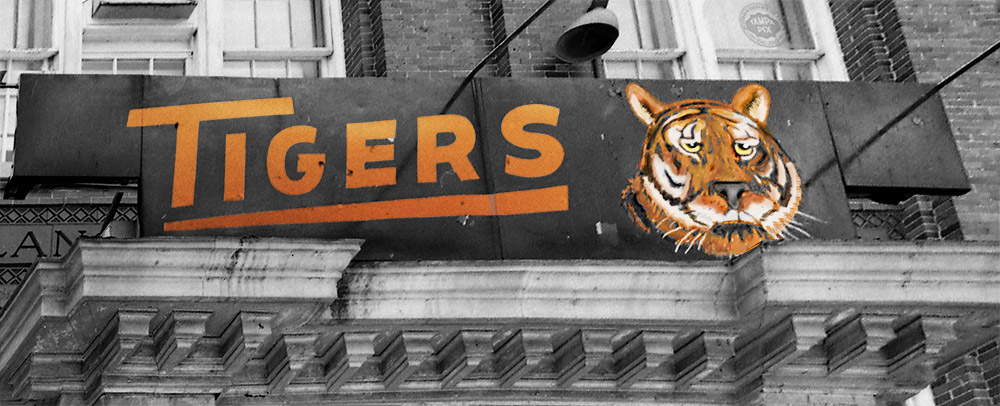
The image above was created from the photo below. |
|
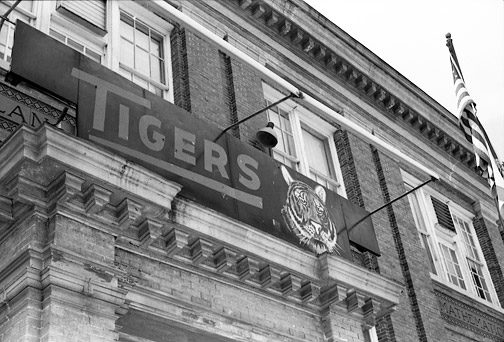
|
After Jefferson
High School was closed, George Washington Jr. High School moved here
in 1967. George Washington Jr. High had
first started operating at 707 E. Columbus Drive in 1915 at a newly
built building which was identical to Woodrow Wilson High
School. Within several decades that George Washington Junior High
became overcrowded, forcing the school to move into the larger, and
abandoned former Hillsborough and Jefferson High School building on
N. Highland Ave. The school lasted 14 years here, closing its doors for good in
1980 due to an enrollment drop to just under 1,000 students.
George Washington Jr. High
School B & W photos from 1978 |
|
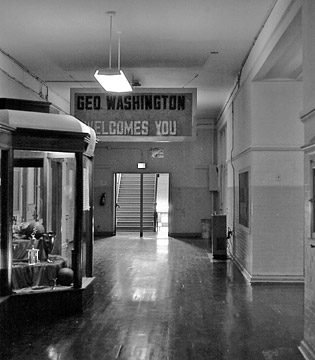
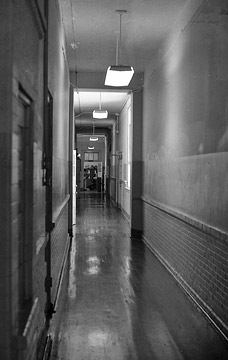
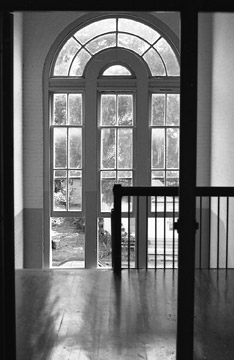 |
|
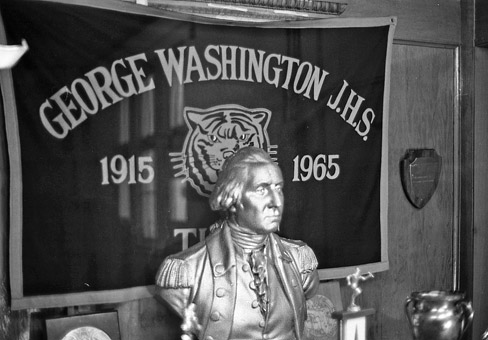
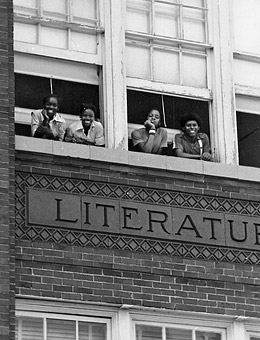
The dates on
the banner represent the starting and ending years that GWJHS
existed at the original 707 E. Columbus Drive location.
GEORGE
WASHINGTON JR. HIGH 1973-74 MARCHING BAND
Directed by James Leone
Photo provided by Rick Garcia
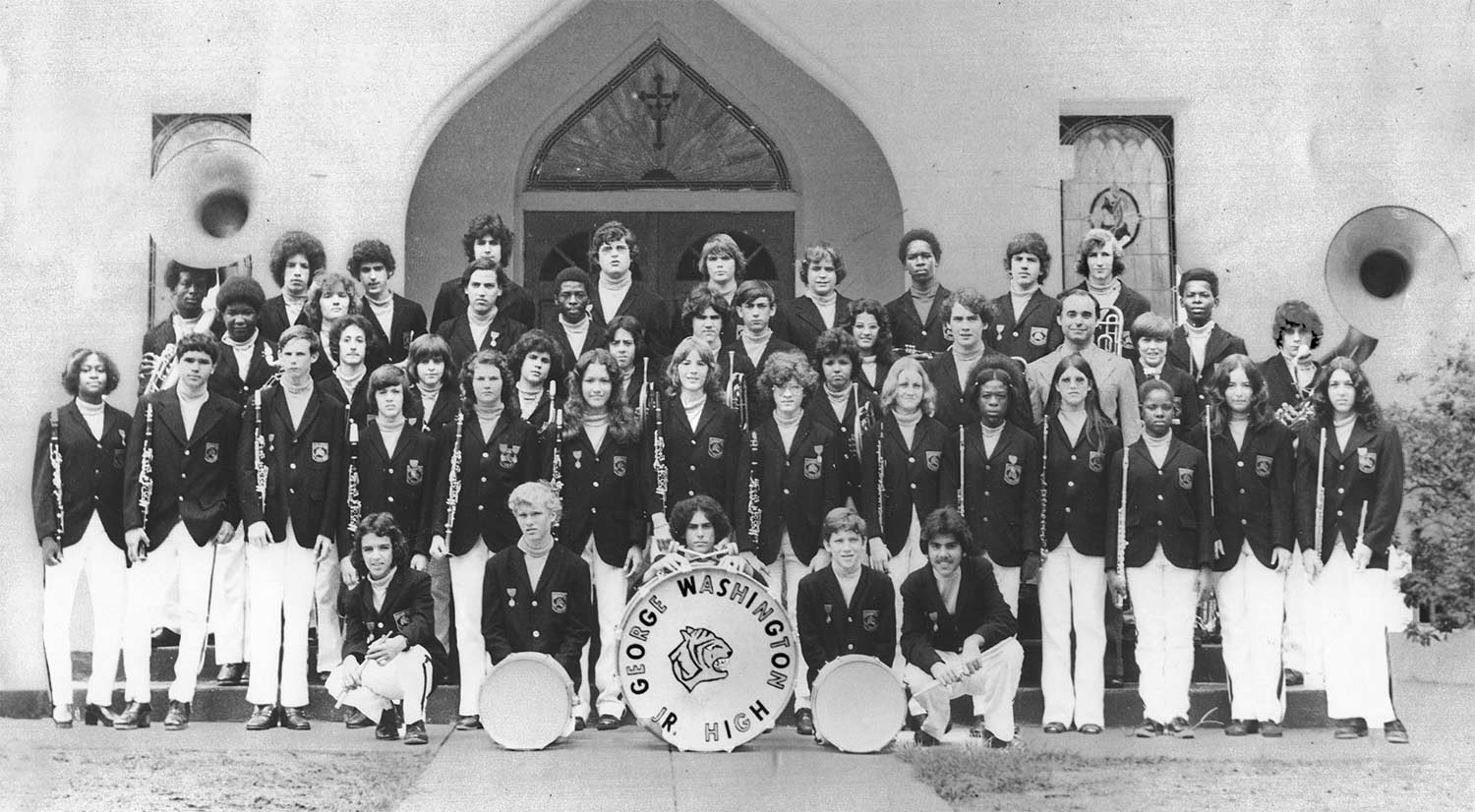
Behind the bass drum is
Braulio Alonso's nephew.
Photo
descriptions of students below are by John Walker from his website
George Washington Junior High School - Home of the Fighting Tigers
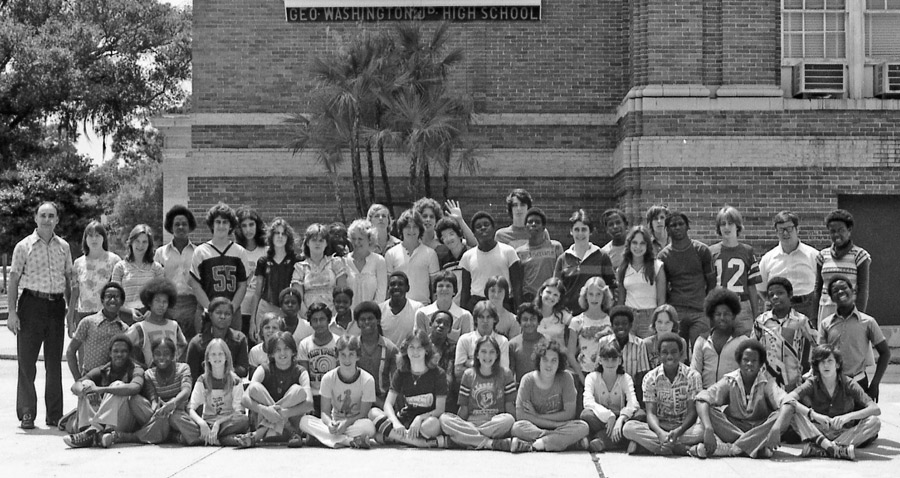
The 1977-78 GWJH
Tigers concert and marching band members with director James Leone
Music
and Choral Director James "Jim the lion" Leone did it all, directing
the bands and choruses, while maintaining a high level of
musicianship within his ensembles. He was a dedicated music educator
who demanded the best from his students. Mr. Leone was much
beloved, although he was known for having a temper when it came to
his band and chorus students "not measuring up" to what he expected.
Mr. Leone remained the Music and Choral DIrector, until GWJH closed
in 1980.
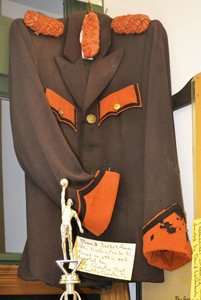
James Leone was a Jefferson High
School Dragon from the proud class of 1955 and went on to attend the
University of Florida and Florida State University where he received
his Bachelors in Music Education in 1959. Mr. Leone returned
home to the Hillsborough County Public Schools as a teacher of band,
chorus, orchestra, and general music at Orange Grove Elementary
School. He held his position until 1966 at which time he moved
to instruct band, chorus, and orchestra at George Washington Junior
High School until 1980 when the school closed, Mr. Leone
finished out the rest of his 38 year teaching career, teaching
chorus at two other junior highs. During all of his years of
teaching, Mr. Leone was working toward his Masters in Music
Education, which he received from Florida State University in 1984.
This band jacket was found in the
attic by construction workers during the 2003 restoration of the old
building. It was very faded and moth-eaten but Royal Cleaners
donated their services to clean it up. The jacket is on
display at the Jefferson High School Alumni Museum at the D.W.
Waters Career Center.
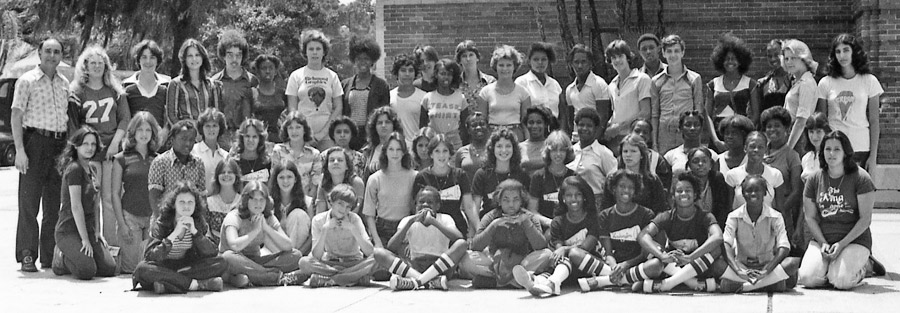
The 1977-78 GWJH
Tigers chorus members with director James Leone |
|
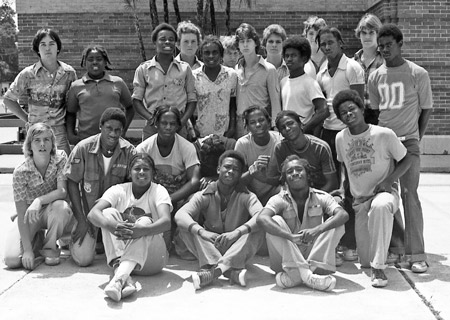 |
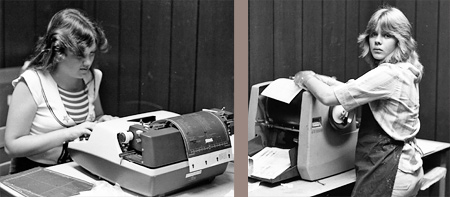
Duplication
technology of the times--cutting a stencil on a typewriter and
running off duplicates on a mimeograph machine. |
|
The Fighting
Tigers football team |
|
|
 |
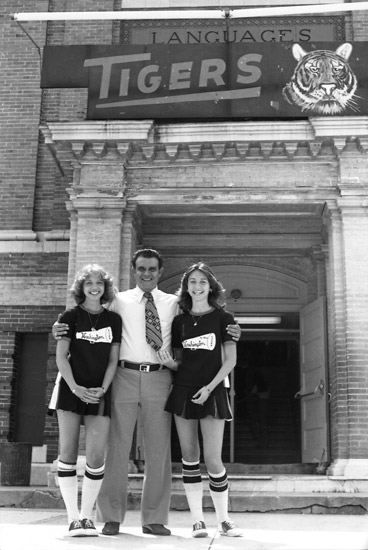 |
|
The GWJH
cheerleading squad
|
GWJH Principal
John Alfano
and cheerleaders |
|
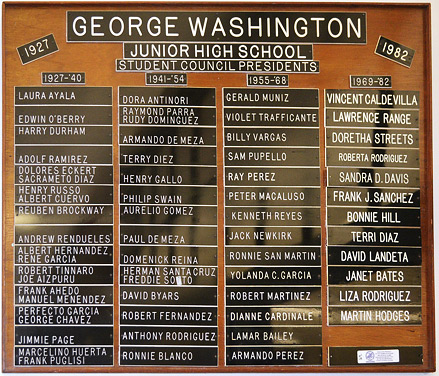
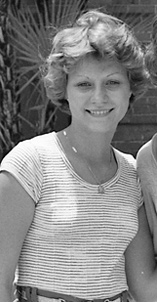 |
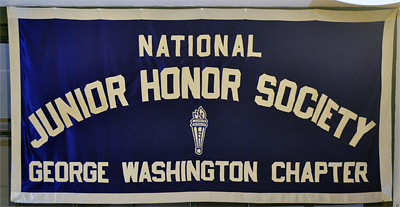 |
|
Along with
other items, this display board of GWJH past student council
presidents was found in a closet by building custodian Jerry
Werner. It is on display at the Jefferson High School Alumni
Museum at the D.W.
Waters Career Center. On the right is Janet Bates, 1977-78
Student Council President. |
This National
Junior Honor Society banner was found in a closet by custodian
Jerry Werner, along with other items. Royal Cleaners
hand cleaned it for no charge. It is on display at the
Jefferson High School Alumni Museum at the D.W.
Waters Career Center.
|
|
The following information by
John Walker was excerpted from his website
George
Washington Jr. High School - Home of the Fighting Tigers
In 1992, the
building served as the operational headquarters and as a shoot
location for numerous scenes in the movie “Cop & a Half,”
directed by Henry Winkler and starring Burt Reynolds and Norman
Golden, II. Burt Reynold’s character “Nick McKenna” was
supposed to be a Tampa Detective who graduated from HHS and FSU.
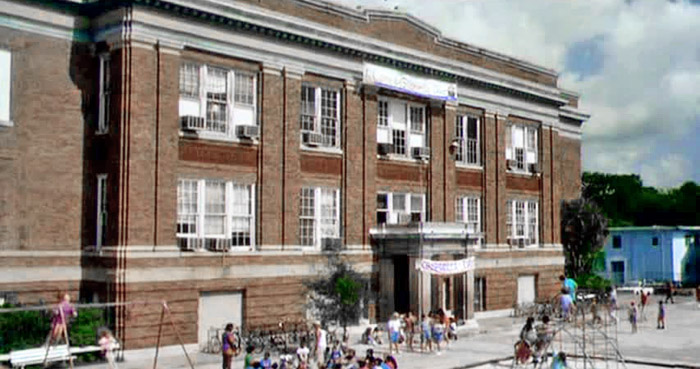
Opening scene
from the movie
The main building
provided office spaces for the administrative, payroll, and
production staffs. It played a key role in meeting the
production needs of the directors--to set up a sound stage; to
accommodate Burt’s apartment set; and to provide the classrooms
and exterior locations that fit the “on screen look” they were
aiming for, which was eventually portrayed on screen in the film.
The movie was shot all over the interior and exterior of the
school.
|
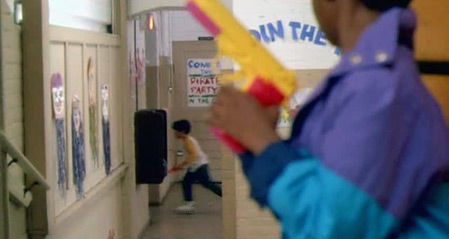 |
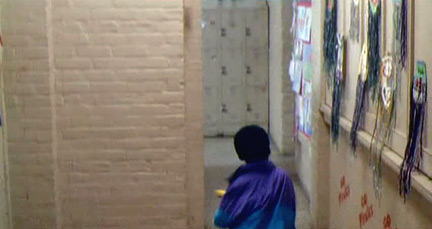 |
| |
|
|
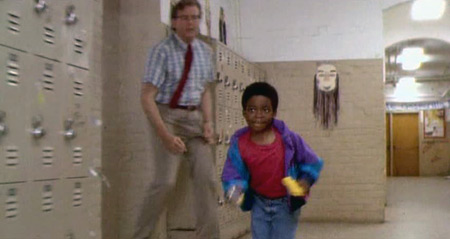 |
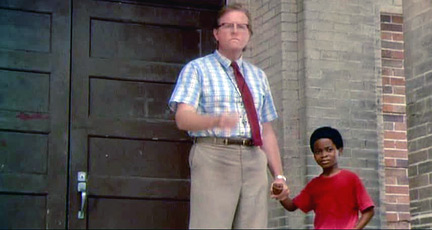 |
| |
|
|
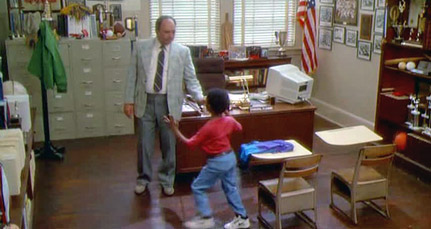 |
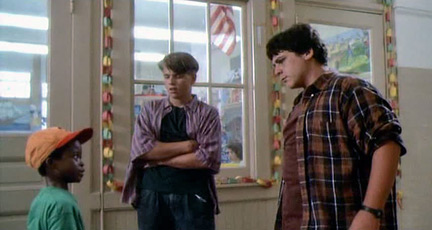 |
| |
|
|
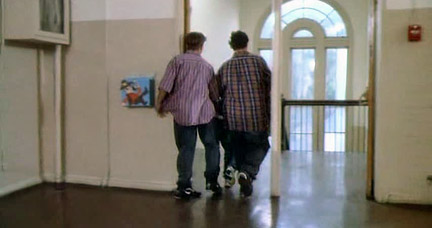 |
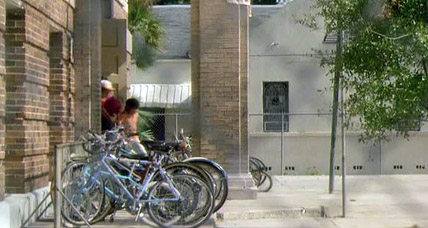 |
| |
|
|
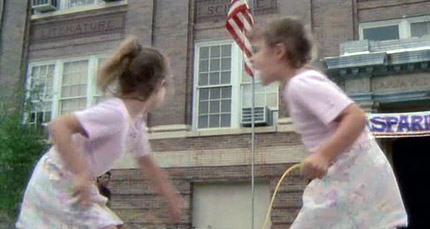 |
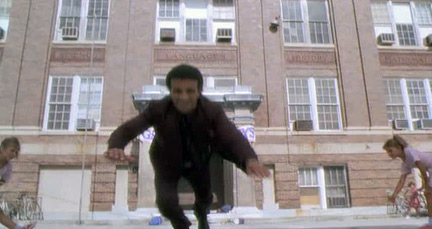 |
| |
|
| |
|
| The entire interior of Burt Reynolds’ apartment seen in the
movie and the hall outside it was all built onto the auditorium
stage at the former George Washington Junior High. A lighting grid
was rigged above the set on the stage, and the daylight seen
coming in Reynolds' window in the movie was directed from out in
the seating areas of the auditorium. None of the scenes of
the interior of Burt’s Ybor apartment were shot in Ybor City
because the rooms and hallways in those buildings on 7th Ave. were
too narrow for the talent, cameras, crews, and boom operators to
work and still get the shooting angles and shots they wanted.
|
|
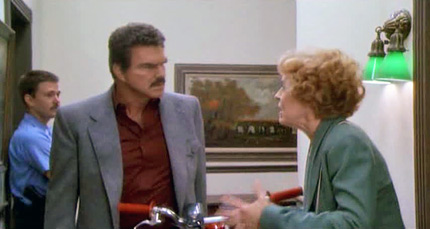 |
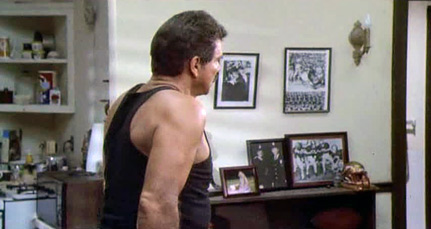 |
| Many of the sports photos on the wall in Reynolds' apartment
were borrowed from Hillsborough High School. They used the now
famous school pictures of HHS’s varsity baseball teams; from the
’81 State Sectional squad of “Doc” Gooden, to the ’80 State
Finals’” team led by Vance Lovelace and Floyd Yoemans. They
even hung the HHS football teams ‘80 District Co-Champ photo and
possibly the ‘81 State Decathlon Championship team photo as well.
All of the photos were blended in amongst the FSU memorabilia,
which were from Reynolds' personal collection. |
| |
| |
|
|
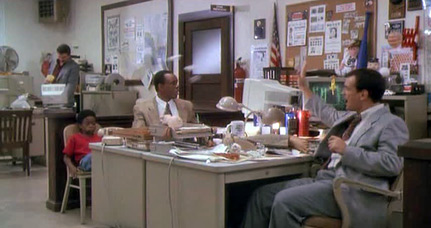 |
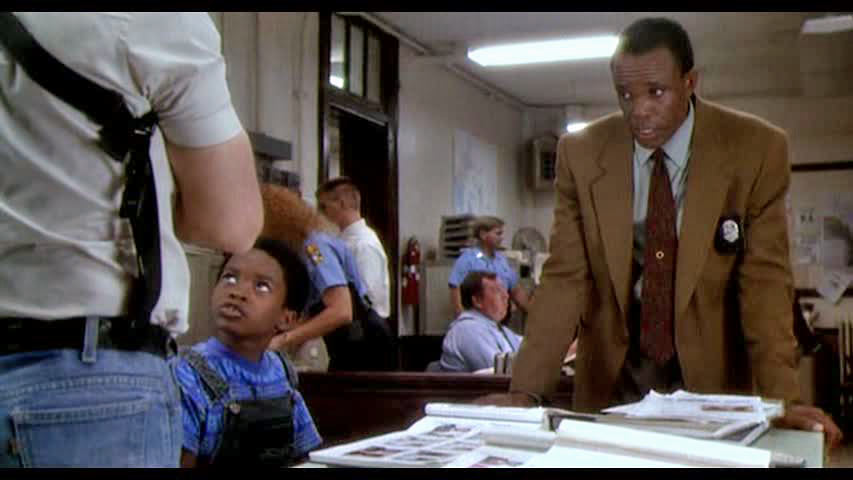 |
| The old cafeteria was converted into the interior of the police
station headquarters and the bathroom across the hall in the
police station scene still had the same old soap dispenser
from the school. |
| |
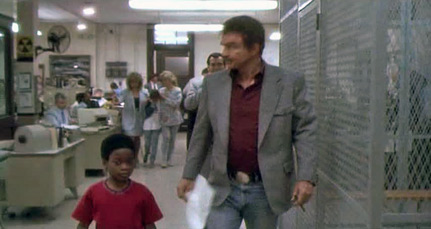 |
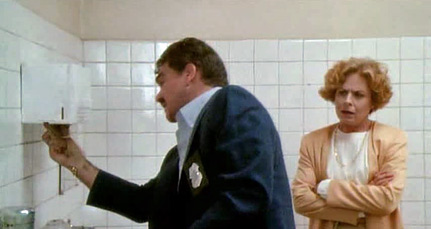 |
Cop and a Half trailer on YouTube
|
|
The first home of George Washington Jr. High School
In 2001, the
Hillsborough County School District sold the abandoned, original
1915 building of George
Washington Junior High at 707 E. Columbus Drive to the FDOT for $380,000. In August of 2004, the
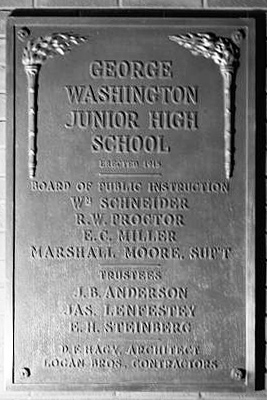 original 1915 George
Washington Junior High School building was finally demolished to
make way for I-4 expansion, despite public outcry, and to the
dismay of many of the schools alums. HARTline used some of
the bricks and architectural accents to erect a nearby bus shelter
on the northeast corner of the original Washington school site. They
mounted a plaque dedicating the bus stop as a tribute to the old
school building. original 1915 George
Washington Junior High School building was finally demolished to
make way for I-4 expansion, despite public outcry, and to the
dismay of many of the schools alums. HARTline used some of
the bricks and architectural accents to erect a nearby bus shelter
on the northeast corner of the original Washington school site. They
mounted a plaque dedicating the bus stop as a tribute to the old
school building.
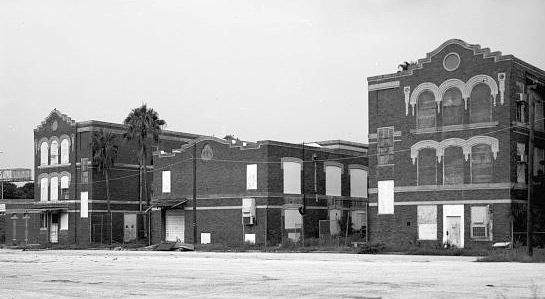
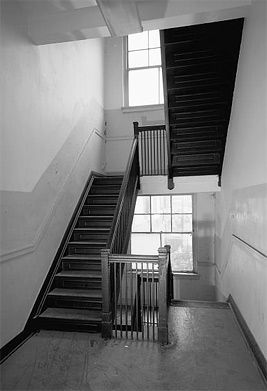
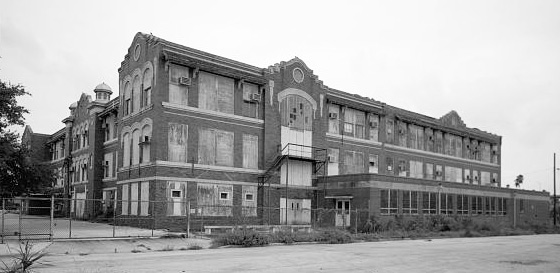
The
first George Washington Junior High School was historically
significant as one of the first two junior high schools constructed
in the nation. The school helped change the organizational structure
of schools throughout the United States. It was architecturally
significant as an example of the Mediterranean Revival style as
adapted to academic architecture in Tampa. An architectural style
most intimately linked with the 1920s Florida Land Boom, the
Mediterranean Revival style was adapted to many early Tampa schools
built in the 1910s-1920s. Although often clad in the traditional red
brick, these schools exhibit arches, shaped parapets, brackets,
pendants, contrasting brickwork, and other details associated with
the Mediterranean Revival style.
See 40 photos of the old GWJH School on Columbus Drive
See 5 architectural drawings of the old GWJH on Columbus Drive
|
|
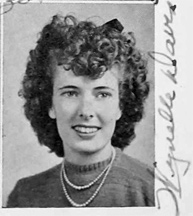 |
THE
D. W. WATERS CAREER CENTER
Special thanks to Wynelle Davis Gilbert, JHS Class of '44, for information and
comments about the building on Highland Avenue and its restoration, the Jefferson
Alumni Association Museum, and her years at Jefferson High
School at this location. |
 |
|
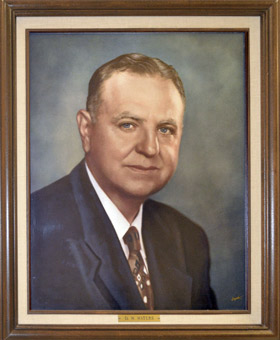 |
|
This
portrait of David Willoughby Waters hangs in the career
center's office. |
In 1993, seven
Jeffersonians went to bat to save their old building on Highland
Avenue, which at the time only housed some offices and was in dire condition.
It took almost 8 years of fighting downtown but in the end they were
successful. On April 24, 1994, due to the their efforts, the school
was renamed the D. W. Waters Career Center (for Jefferson High
School's first principal), a County Public Schools center for 11th
grade and 12th grade students focusing on occupational training and
in
2003 the building benefited from a major restoration. On May
15, 2007, it was added to the U.S. National Register of Historic
Places.
|
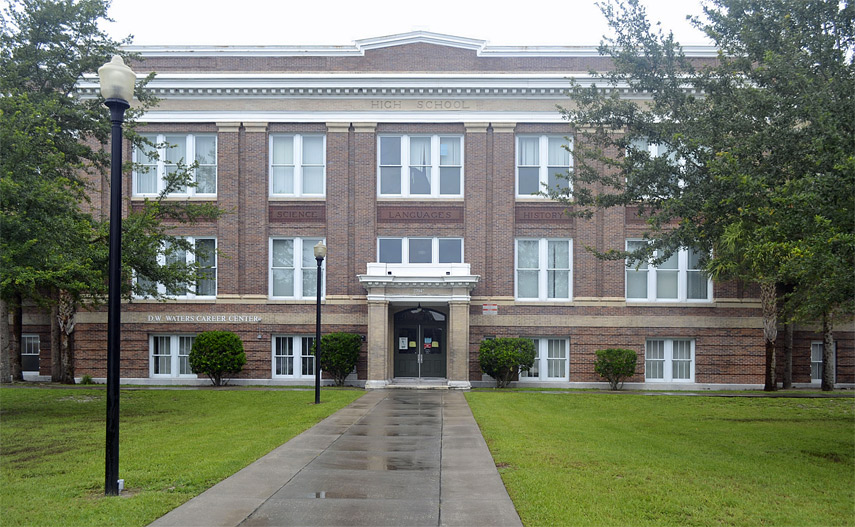
The front
of the school faces east and is the original portion of the
structure completed in 1911. It consists of three
floors, with the first floor partially below ground
level. The second floor is the school's main floor.
When you enter the building, there are stairs to go up to
the main floor on the 2nd floor, or down a half flight to
the 1st floor. During the Hillsborough and Jefferson
years, the first floor was often referred to as "the
basement" and the second floor as "the first floor."
|
|
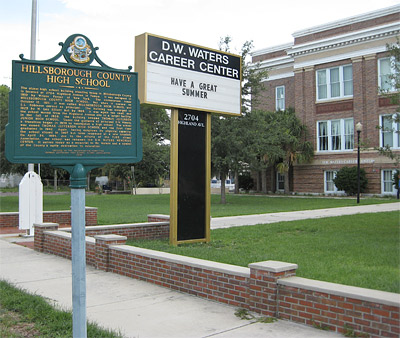 |
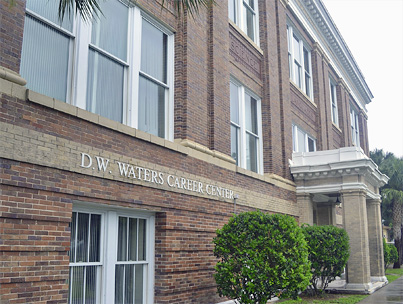 |
|
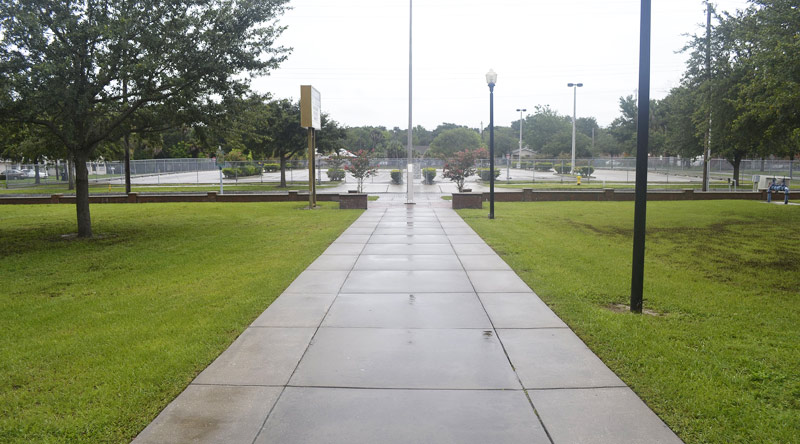 |
|
A view
looking east towards Highland Ave. from the front entrance |
|
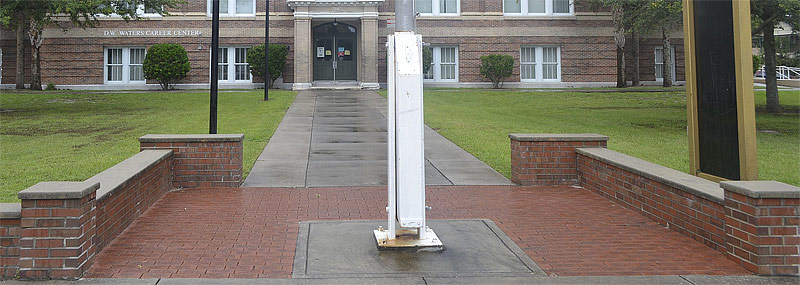 |
|
The
Rally Around the Flagpole Memory Walk was begun in
April of 2002 and was a huge success. Almost 700 bricks
were sold. Rebuilding of the brick low walls which once
surrounded the school yard long ago was special request of
the Alumni Association when the building was restored. As
part of the restoration project, the concrete paving
installed on the yard during WWII was removed and the yard
restored. At this time, numerous artifacts from
before the paving were unearthed by the workers and
donated to the museum.
|
|
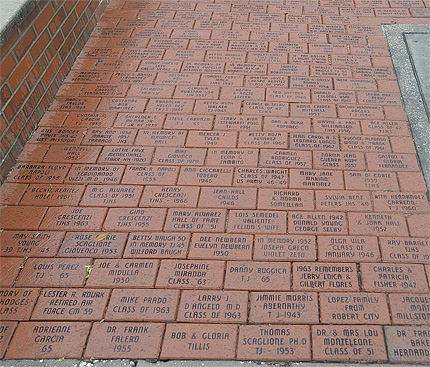 |
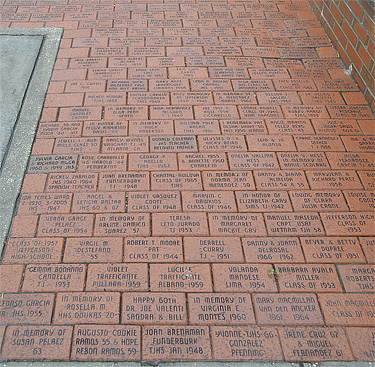 |
|
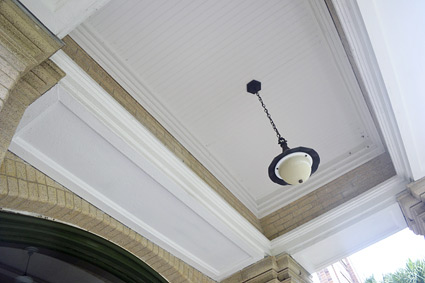 |
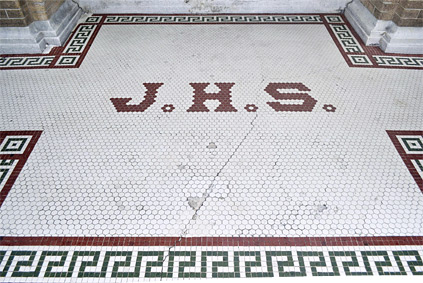 |
|
The
ceiling at the front porch of the building |
The
floor at the front porch of the building. It
formerly had "H.H.S." but was changed to "J.H.S." after
Jefferson High School was founded here in 1939. The
color shades of the brick red and pine green tiles were used
in the building's interior. |
|
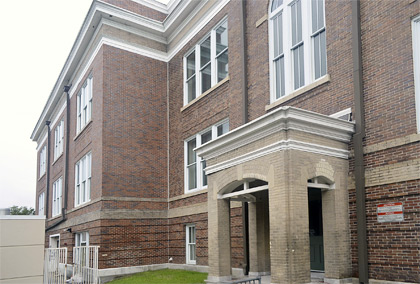 |
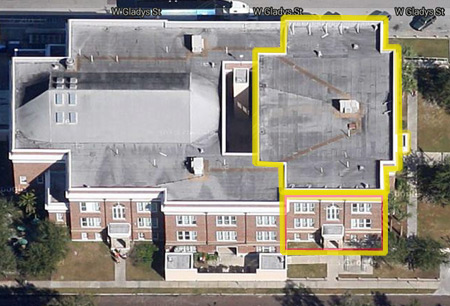 |
|
On the south face of the
building you can see the original 1911 structure on the
right and the 1923 addition on the left. |
This satellite image
shows the original 1911 structure outlined in yellow and the
1923 addition to the left of it. |
|
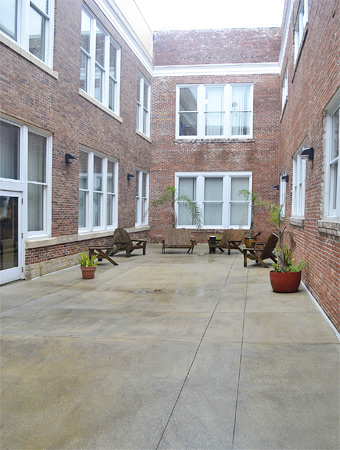 |
Looking
south from the elevator, this is the patio situated on the
2nd level between the old and new structures. The 1911
portion is on the left, the 1923 portion in the background
and on the right. On the left is the door to the
museum-media center. The blue arrow below shows the
vantage point of the photo at left. (Note: This floor plan
is rotated from the normal view of north at the top to
correspond with the photo at left.)
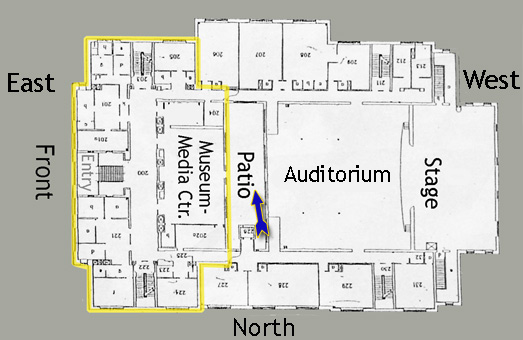 |
Originally, the patio was an open atrium at ground level
with a fishpond where one could sit outdoors and eat lunch but when
the restoration was done in 2003, the ground level was
enclosed with a floor and ceiling and a floor was built on
the roof of the space to create the 2nd floor patio. The patio serves as a lunch spot for teachers and as an
overflow when meetings or reunion parties are held in the museum. For the rededication ceremony, this area was set up
with tables and chairs, flowers, cloths and a lovely array
of finger foods - all catered by the Jefferson-Cypress culinary
department. Their students were dressed in black pants and
white shirts and did the serving. Close to 200 attended and
almost the entire School Board.
|
|
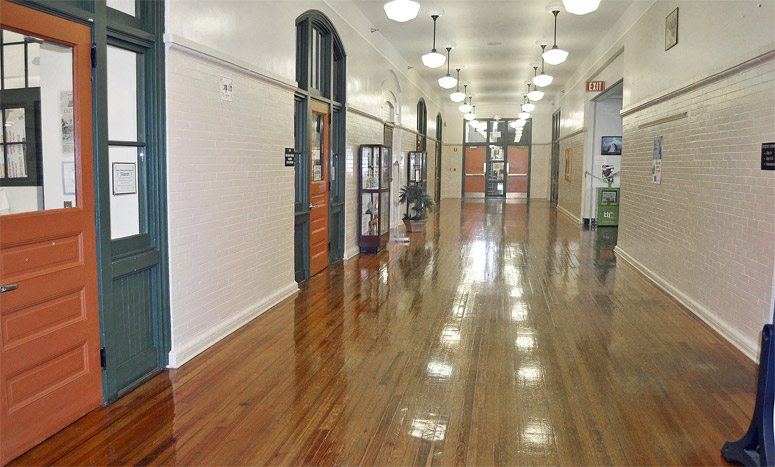 |
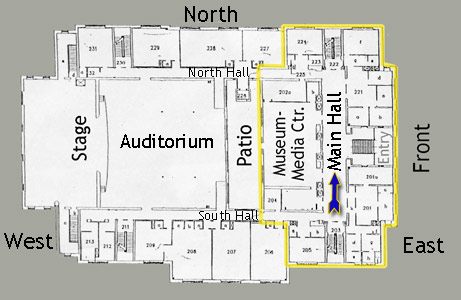 The
photo above is a view of the main hallway, marked with
a blue arrow on the 2nd floor plan at right. The
opening on the right side of the hallway leads to the stairs
down to the front doors of the building. On the left
side of the hallway, in the center of the photo, is one of
the entrances to the Museum/Media Center. The
photo above is a view of the main hallway, marked with
a blue arrow on the 2nd floor plan at right. The
opening on the right side of the hallway leads to the stairs
down to the front doors of the building. On the left
side of the hallway, in the center of the photo, is one of
the entrances to the Museum/Media Center.
The
floors are original to the 1911 building, having been
beautifully restored. The interior colors are also
true to the old high school color scheme. |
|
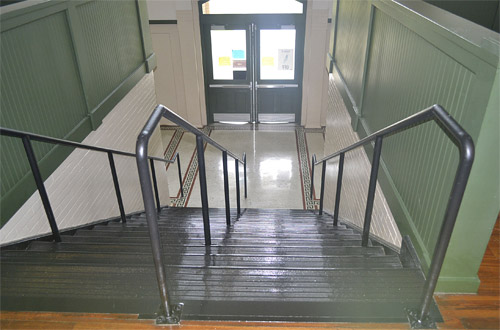 |
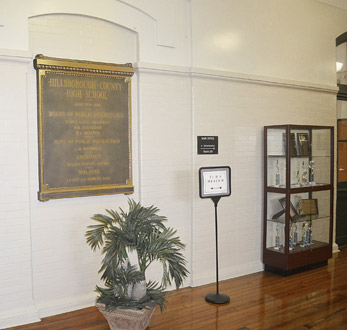 |
|
Stairs
from the 2nd floor down to the 1st floor front doors |
The bronze
plaque in the main hallway is a replica of the original
which is displayed at the entrance to the Education building
offices downtown.
See the plaque larger |
|
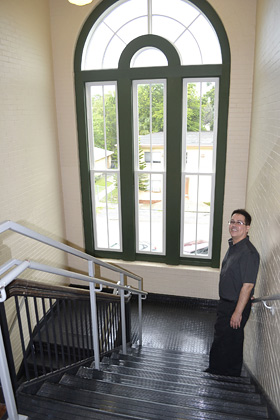 |
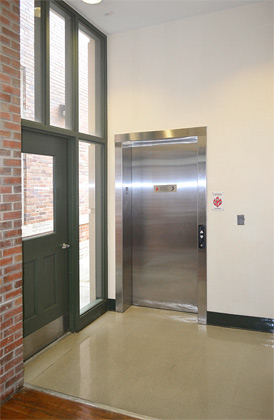 |
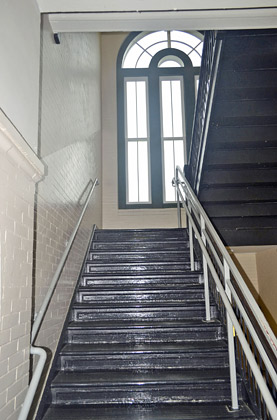 |
|
Rex
Gordon on well-trodden stairs. The windows are exact
copies of the originals. |
In order to function as a
school again, the building had to have an elevator installed
to make it handicapped accessable. It was added in the
patio space along the north hallway. |
Back in 1993 when the
Save Our School Project first started, the
windows were broken, pigeons and birds were roosting there,
and the roof was leaking. It was in sad shape. |
| |
|
|
|
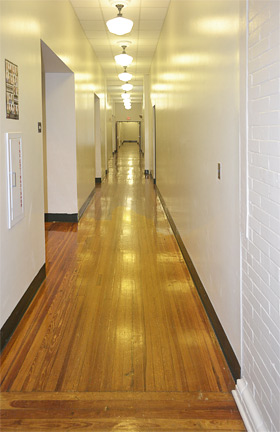 |
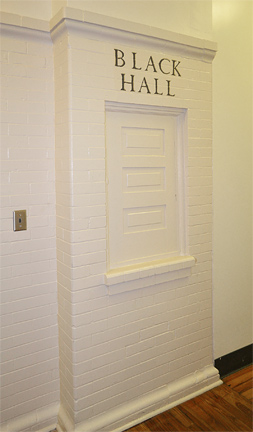 |
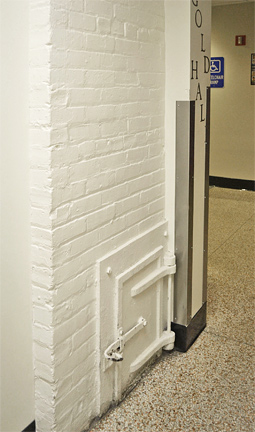 |
|
Looking west along the
north hallway from the original 1911 building into the 1923
addition. The lengthwise floor boards and the smooth
wall beyond the brick wall mark the start of the addition.
On the left can be seen the entrance to the elevator
vestibule. |
The door to a
long-inoperative dumbwaiter system in the south hallway.
Hallways in the building have names such as Black Hall, Gold
Hall, Cheetah Hall, etc. |
Access to
possibly a coal chute, furnace-related equipment or
plumbing. |
|
.

The
Kay Moore Morse Auditorium
The seats are arranged in straight rows; the apparent
curvature of this photo is due to wide angle lens
distortion.
|
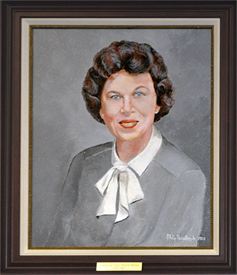
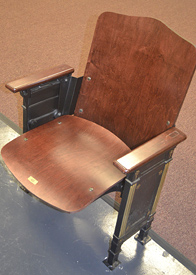 The
auditorium has around 600 seats that were made in the style of
the original seats which were not able to be restored at
reasonable costs. The only difference is that the
current chairs are wider to accommodate today's generally
larger students. The
auditorium has around 600 seats that were made in the style of
the original seats which were not able to be restored at
reasonable costs. The only difference is that the
current chairs are wider to accommodate today's generally
larger students.
Kay Moore
Morse, Class of 1943, who founded the Alumni Association, worked
diligently to get the building on the National Register. She
started the "Save Our School Project" to rescue the
building, the museum, and sales of
bricks around the flagpole as a fundraiser. The auditorium was named for her
in honor of all her work and years of service to keeping this
building in the system.
Portrait by Philip
Rosseter, Jr., JHS '46.
|
|
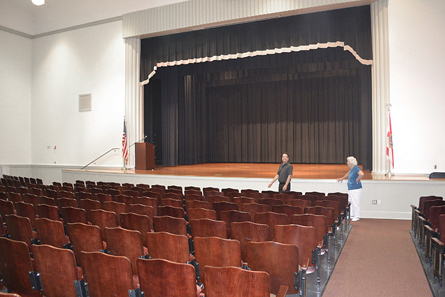 |
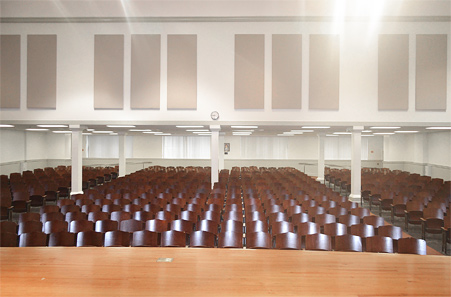 |
|
Behind the stage are
dressing rooms and restrooms. Back in the 40's the boys and girls
played their basketball games on the large stage and dances
were held. With only 3 feet beyond the court end
lines, players would often run into the walls. |
The auditorium seating
originally featured balcony seating, but
unfortunately, the decision was made to convert the space
into classrooms instead of restoring the balcony.
|
|
. |
|
|
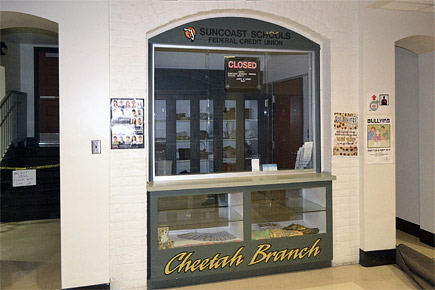
The
bookstore on the first floor of the D.W. Waters Career Ctr. was the original location of
Ed's snack and school supplies counter during the
Hillsborough years.
Read more about Ed and
his store.
|
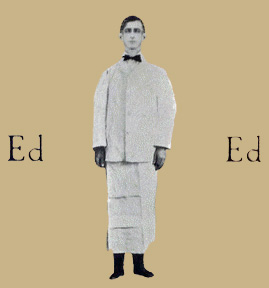 |
|
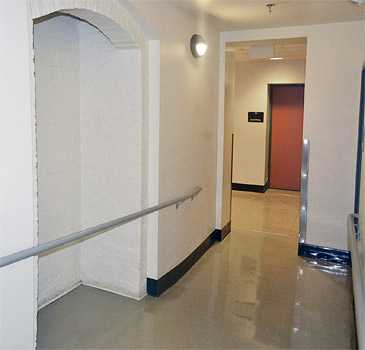 |
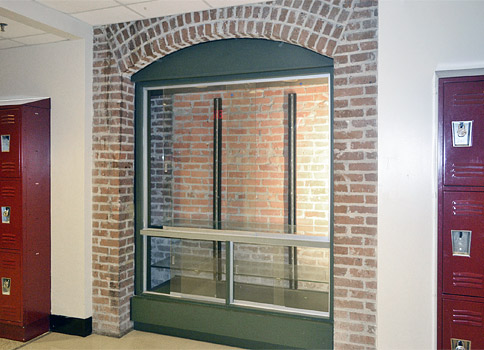 |
|
The
handicapped entrance on the first floor. The original
terrazzo floors were restored and refinished to shine like
glass. |
A showcase
on the first floor |
| |
|
|
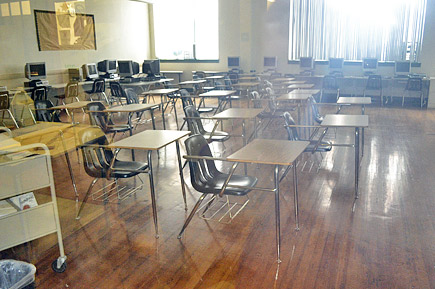 |
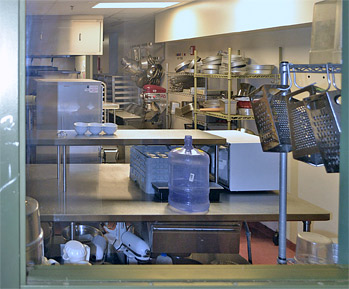 |
|
A view
through the window of a classroom on the second floor |
A view
through the window of the culinary arts department |
| |
|
|
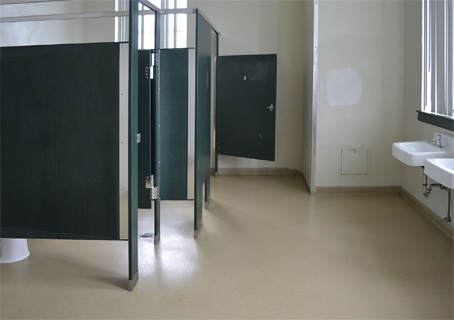 |
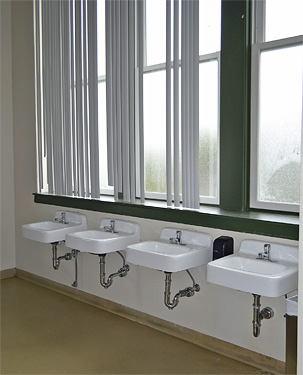 |
|
The
boys restroom |
The
boys restroom |
|
|
|
|
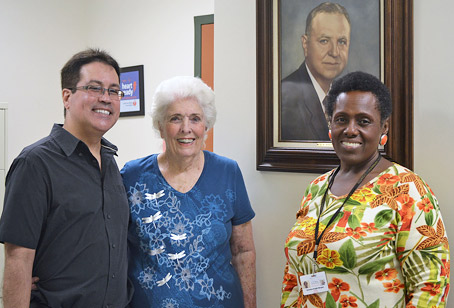 |
HHS
historian Rex Gordon, JHS Alumni Museum curator Wynelle
Davis Gilbert, and the D.W. Waters Career Center principal
Veronica Knight Morgan.
The D.
W. Waters Career Center provides quality performance based
career preparation programs and training facilities for
at-risk youth. They serve students who are not succeeding
academically at one of the district’s comprehensive high
schools, or who are over-aged middle school students.
Students are given a second opportunity to graduate high
school at an accelerated pace while getting started with
training in a career of their choice. They combine academic
and technical training that will assist students in entering
college, an advanced technical training program, the
workforce, or the military.
Visit
the D. W. Waters Career Center website. |
|
The
Eight Homes of Hillsborough High School
Cornerstone
history of Hillsborough High School scan of original document
Jefferson
High School Alumni Museum
Tampapix Home
|



